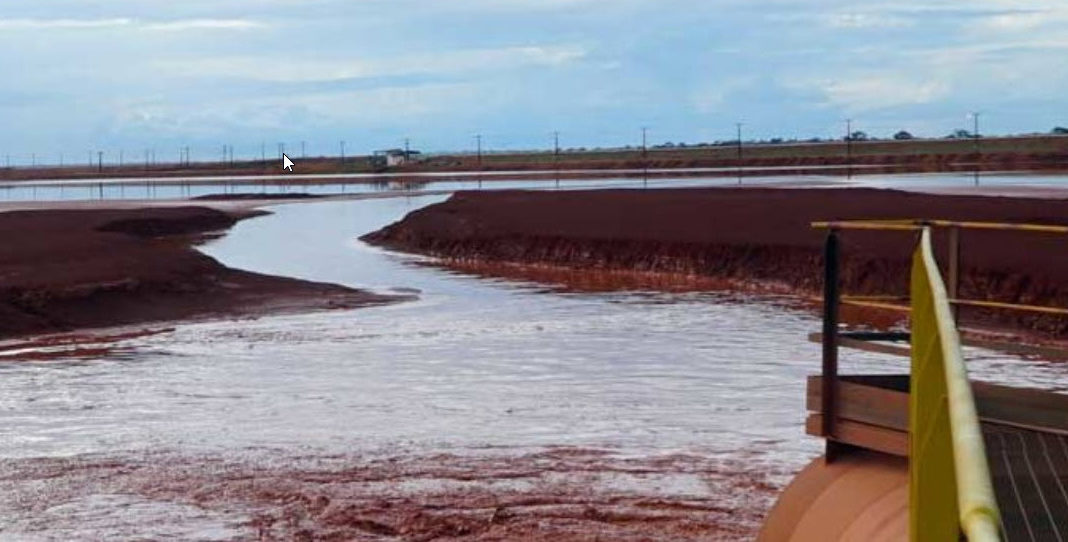- Mineração Rio do Norte (MRN), the world’s fourth largest bauxite producer, encroached on riverine communities beside the Trombetas River in the Brazilian Amazon in the 1970s. Over the years, MRN became notorious for its contamination of local waters with bauxite mining waste, residents say.
- To resolve that problem, the company built 26 tailings dams. The largest of these waste-holding impoundments covers 110 hectares (270 acres). The entire system for managing mining waste encompasses 1,700 hectares (4,200 acres) and is located within a national protected area.
- Brazil has suffered two catastrophic mining tailings dam collapses since 2015, leaving Trombetas riverine community residents concerned about the 26 MRN dams.
- Brazil’s National Agency of Mining has rated one of MRN’s dams as “high risk.” Fourteen more, should they fail, possess “social, environmental, economic and mortality risk.” MRN says its dams are safe. Locals are also worried over possible water contamination and loss of traditional livelihoods
This story is the second in a series reporting on the legacy, current status and likely future of bauxite mining in the Trombetas river basin and Amazon delta. Journalist Sue Branford and filmmaker Thaís Borges journeyed there in February, 2020. Their investigation of aluminum production is especially relevant now, as Brazil’s Bolsonaro administration pushes to open the Amazon’s indigenous reserves and other protected areas to large-scale industrial mining.
ORIXIMINÁ MUNICIPALITY, Pará state, Brazil — When our Mongabay reporting team visited the Amazon riverine communities of Boa Nova and Saracá, one theme predominated: “My children’s future is here,” said one resident. “I don’t want to leave this land,” declared another. “I’m only leaving here to go to the cemetery,” a third emphatically stated.
But this determination to remain on their land is interwoven with another, darker refrain: the people’s expressed unease at living in the shadow of numerous large tailings dams, some less than 20 kilometers (12 miles) from their homes, all constructed and owned by Mineração Rio do Norte (MRN), the world’s fourth largest bauxite producer, located beside the Trombetas River.
This concern was first sparked in 2015 by an unprecedented environmental disaster occurring a thousand miles away in the town of Mariana in Minas Gerais state. There a tailings dam holding back iron mining waste belonging to Samarco — a joint venture between two international mining companies, Brazil’s Vale and the UK’s BHP Billiton — collapsed. A mud tsunami obliterated the town of Bento Rodrigues, killing 19, and polluting 500-miles of river to the Atlantic Ocean.
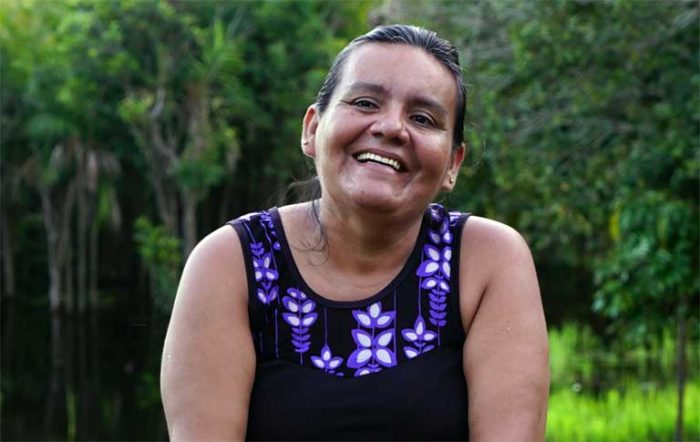
MRN has 26 tailings dams, meaning that the municipality of Oriximiná, home to the bauxite mine, includes more dams within its boundaries than any other district in Pará state. But before the Mariana disaster almost nobody local knew much about the bauxite waste lagoons and the dams holding them back.
Many were upset when they found out. “I got scared when I saw the large number of dams and the size of them,” remembered Fátima Viana Lopes, coordinator of the Boa Nova community, describing her first visit to MRN’s mining waste disposal operation. The lagoons are “so huge that they’ve even got boats sailing on them,” she said.
The largest covers 110 hectares (270 acres); the dams holding back the waste are typically 17 meters (40 feet) high, lower than in Mariana. The entire system for managing waste encompasses 1,700 hectares (4,200 acres), according to MRN.
“If one of those dams burst, I don’t think we’d be able to go on living here,” Lopes said.
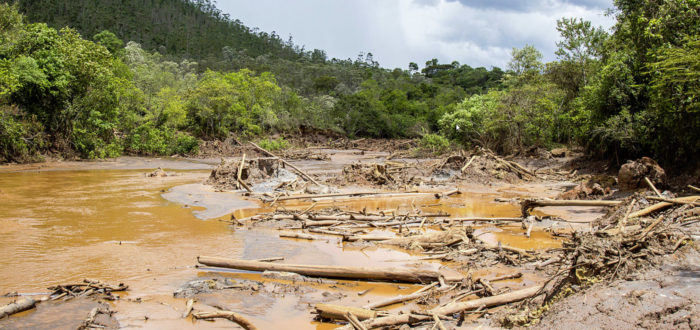
Developing world inequity?
Luiz Jardim, a lecturer at Rio de Janeiro’s Universidade Federal Fluminense, criticizes the inequity of international geopolitics and of corporations that reward the developed world with immense mineral wealth, while transferring the bulk of socio-environmental risks for large-scale mining to the developing world.
“It’s above all in the poorer countries where the largest number of [tailings] dams are located and where environmental damage and deaths occur,” he wrote in a recent research paper. In his view, it’s not by chance that, barely three years after the Mariana tragedy, the Brumadinho tailings dam burst, also in Minas Gerais state, killing 259 people, all swept away by a wall of mud.
“In both cases the companies told the population that the dam was safe, just as MRN is telling us,” said Lopes.
Another community leader, José Domingos Rabelo, believes that if one of MRN’s dams failed, the chaos created would be far greater than the company suggests. “Not only Boa Nova and Saracá would be affected, but a total of 16 communities,” he stated. “If an accident occurred, 3,000 people would be driven out.” Rabelo is referring to the densely occupied traditional communities around Sapucuá Lake, a large waterbody west of the town of Oriximiná (see map).
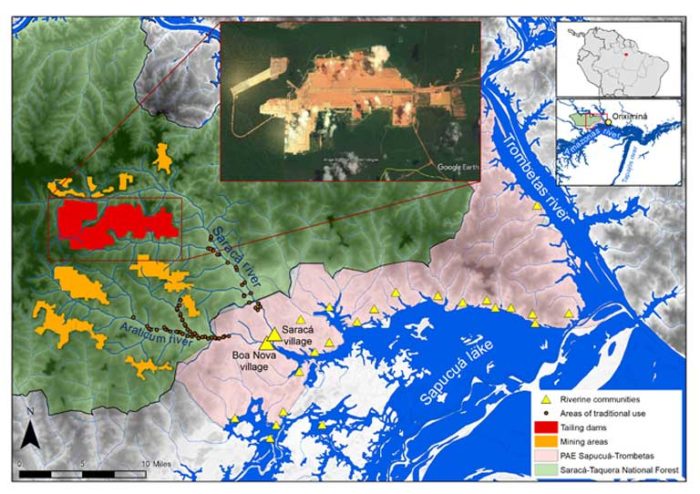
The mining company assures the communities that risks are minimal and that the dams are safe. MRN engineer Marcela Pellegrini, standing beside one of the tailings dams, explained that the company’s waste impoundments were not built using the flawed technique employed at both Mariana and Brumadinho. She says that a safer method was utilized, and this fact, along with the flat terrain and lower height of the dams, makes the MRN complex much safer.
A National Agency of Mining (ANM) assessment of MRN’s dams is not so reassuring. One dam has been rated “high risk” by the ANM, because some of its features “can influence in the probability of an accident.” Another 14 possess “a high potential of associated risk,” the assessment says, which means that, in the hypothetical case of a dam failure, there could be “social, environmental, economic and mortality risks”.
“We are in the Amazon forest and, if waste falls into a creek flowing round the Saracá Plateau [where the dams are located], the water will become cloudier and more fish will die,” the MRN representative explained. But she stressed that, even in the improbable case of a breach, it is unlikely anyone would die. MRN practices diligence, monitoring the dams daily, she says.
But Lopes questions this optimistic evaluation. She notes that while no immediate deaths might result, serious environmental damage could have a huge negative impact on traditional communities in the long run. “I don’t think we’d be killed outright in an accident, but die, little by little,” she says. She wonders if such a spill could turn them into enviro-refugees: “Imagine us moving into towns? Without jobs, how would we live? Our biggest concern is that we have nothing on paper saying what would happen to us” in case of disaster.
Perceived problems in the development of the giant bauxite mine and its waste disposal system since the 1970s has raised multiple doubts. In his research paper, Luiz Jardim points out that in the 21 different licensing procedures that MRN went through with IBAMA, the Brazilian government’s environmental agency, the mining company was never required to fully analyze the environmental impact of the waste disposal system nor to present a set of proposals for mitigating its impact on the local communities and for compensating them.
Lúcia Andrade, the director of the Comissão Pró-índio de São Paulo, an NGO that works with the communities, says that one of the problems is that dam monitoring by ANM lacks transparency. The mining agency’s reports are not made public, supposedly to protect the company’s industrial property rights, but leaving local people without access to the agency’s safety assessments.
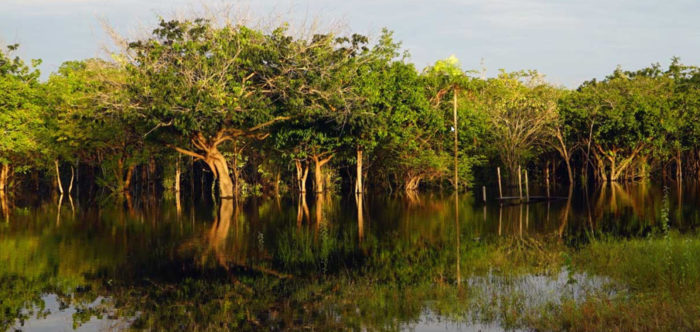
Impacts stem from decades of mining
Raimundo da Silva, known as Daca, one of the oldest inhabitants in Saracá, possesses a vast repertoire of interesting anecdotes, acquired over seven decades, that he loves recounting. Born into one of the intrepid pioneer peasant families who moved into the region early on, his mother told him he was nearly carried off by a hawk as a baby. He recalls a very happy childhood: “It was a paradise here, the water was so clear, so beautiful!”
He remembers the communal “puxiruns,” organized by neighbors to help each other plant subsistence crops, with a host providing a celebratory lunch when work was done. “I remember going down to the river and catching 86 tambaqui, to feed the 80 or so people who helped.” Then came MRN, he laments. “Today I would be lucky to catch far fewer than that, so we can no longer carry out ‘puxiruns.’”
Even so, he seems content, having been reunited with his first love, Maria. “We met at a party, when I was 21 and she was 17,” he recalls. Life took the two separate ways, but five decades later, they met again, both widowed, then got married. Daca declared that the only thing marring his happiness today is seeing the environmental damage brought by MRN.
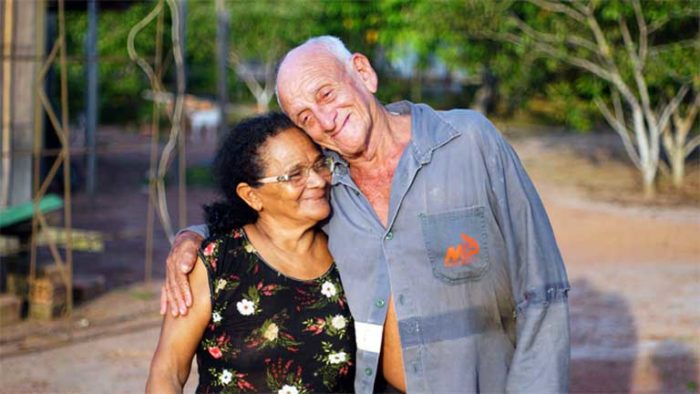
He remembers the once crystal-clear water in the river channels and creeks near the hamlet, which he says are now reddish in color and murky, with the water causing rashes, allergies and intestinal upsets.
“Children here have almost died from sickness and diarrhea,” recalls Daca. “That’s why I said to the president of the mining company, when he didn’t want to install a system for providing clean water because it was expensive, that, if one of my grandchildren died or even one of us grownups, it would be the company’s fault.”
Responding to this and other contamination complaints, MRN built artesian wells and other systems to deliver better quality water to Saracá and Boa Nova. The systems were installed free of cost, but local families, who have little cash income, must pay for the fuel that runs them.
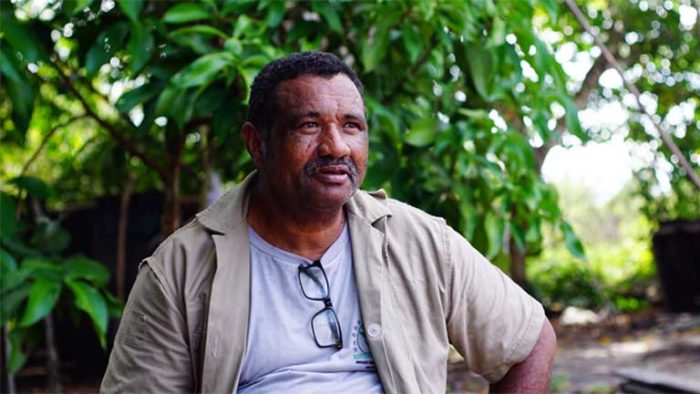
Residents are still not convinced it’s safe to drink the water, wondering if the aquifer too is polluted. “The mining company’s employees bring mineral water when they visit and don’t touch our water,” reported José Domingos Rabelo. “Why not?”
Boa Nova resident Domingos Gomes told Mongabay that the new system installed in his house was problematic for a long while. The water that came out of pipes, he said, was reddish, and people had to let the sediment settle to make it drinkable. “I was even reluctant to put that water on plants,” he says. Gomes believes that MRN sorted out the problem because of the negative publicity generated by an alarming photo published by Comissão Pró-Índio de São Paulo.
MRN was “ashamed when everyone in the world could see that the water was clearly not fit to drink,” he said.
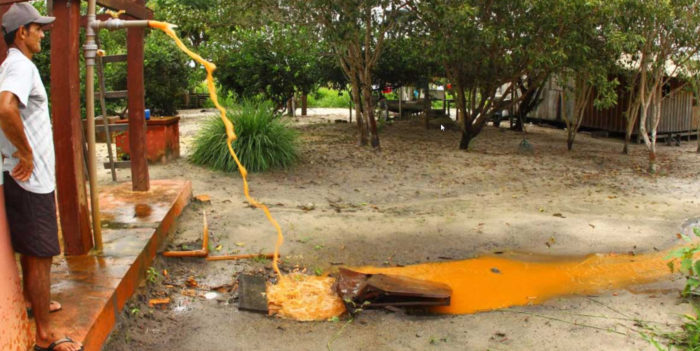
Water controversy continues
Throughout the year, MRN analyzes hundreds of water samples taken from different places along area rivers and streams. “Our results suggest that the company’s activities have not created a problem of water contamination,” MRN Sustainability Director Vladimir Moreira told Mongabay. He explained that, despite its reddish color and murkiness, the water in the rivers and creeks is within the legal quality limits set by Brazilian legislation. The residents are not convinced. “If this water isn’t polluted, why did they install the new systems?” asks Rabelo.
“The company’s capital comes from a series of multinationals — the big multinationals in the aluminium chain,” Moreira said. So, in addition to “the controls required by Brazilian legislation, we apply all the controls demanded by Canadian, Australian, South African and British legislation.”
Lúcia Andrade says that the communities’ reports about the problems they face in the creeks and even in the artesian wells suggest that the monitoring carried out by the company isn’t sufficient to diagnose the wide-ranging impact of the mining on water resources. And she also wonders whether there should be different drinking water standards for the Amazon region, where people consume water directly from rivers and creeks: “The [government] criteria were established thinking of water in towns, where it will be purified before it is consumed,” she explains.
Marcelo Lima, from the Evandro Chagas Institute, a research body linked to the ministry of health, emphasizes current uncertainties: “What is murkiness? It means that there are a lot of particles in the water,” he says. Lima has seen no results from local water analyses as yet, but regularly carries out tests on water potentially contaminated by mining and has found that it can “contain elements like lead, copper, arsenic and mercury.” However, he adds, toxic elements naturally exist in the “geological origin” of bauxite, and no one knows whether these toxic elements might be reaching local populations in Oriximina or if they are “bioavailable,” that is, in a form that can be absorbed and harm people.
Riverine community residents are reluctant to accept the company’s reassurances. “The problem is that the water analyses are carried out by people paid by the company,” explains José Maranhão. “We want independent analyses, carried out by people reporting to the community.” This may happen soon. According to Prosecutor Lilian Braga, from the Pará State Public Ministry, a group of independent public litigators, one of their technical teams has taken samples of the water around the mine and the results should be available shortly.
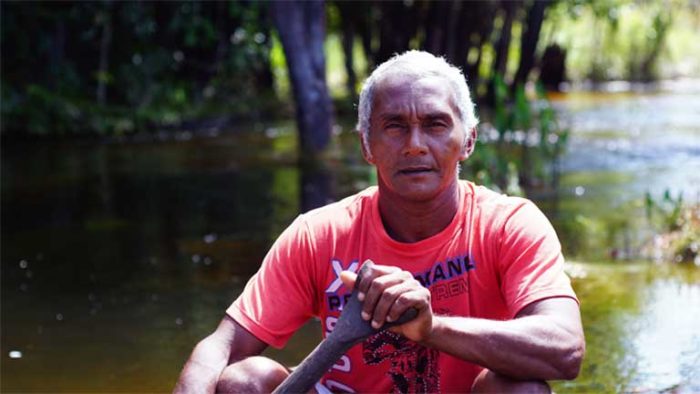
Another resident, Jones da Luz, born in Boa Nova 45 years ago, says he is is a keen observer and feels sure local water quality has changed over the years. He says that during the summer dry season, MRN’s mining activities result in great clouds of dust, with a fine reddish powder covering vegetation in the forest.
“When it rains, the water takes it all into the stream,” he adds.
He has also noted a fall in water volume in recent years: “Saracá Creek used to be deeper but the level’s fallen, because the company pumps out water to wash the bauxite,” he said. His observation is partly corroborated by MRN, which notes that, while in the rainy season it can supply all of the water it needs from its dams, the firm needs 30% of Saracá Creek’s water during the dry season.
It’s scarcely surprising then that there’s been a decline in the number and variety of fish species in the creek, da Luz comments. “There used to be a lot of pirarucu [a large Amazon fish] here, but they’ve all disappeared.”
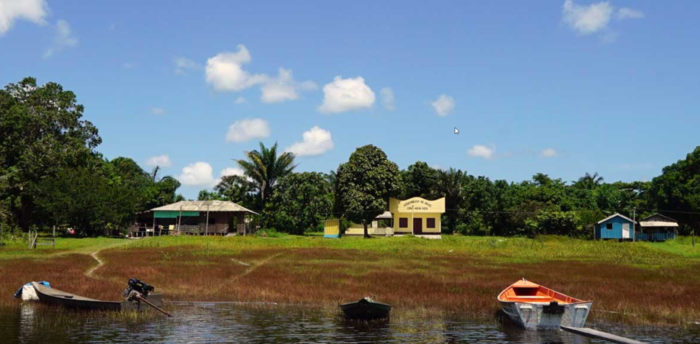
Possible double standard
Outsiders are surprised to learn that all of MRN’s bauxite mines and tailings dams in Oriximina are located within a protected area, the Saracá-Taquera National Forest (FLONA). Because FLONA was created in 1989, after the company arrived in the area, the firm was authorized to carry on with its operations.
Meanwhile, the riverine families struggled to get their age-old sustainable hunting and gathering occupations regularized by officialdom, villagers told Mongabay. Their livelihoods were finally recognized in 2010, with the creation of the Agro-Extractive Settlement of Sapucuá-Trombetas. However, while that designation includes the immediate settlement and its houses, it does not include the forests where the people hunt and collect forest products.
In addition, there are continuing conflicts between MRN and the traditional communities because areas where the company has been authorized to mine are often superimposed atop areas used by the communities for their livelihoods.
As mining activities regularly expand, local inhabitants suffer new impacts. In 2002, for example, the opening of the Almeidas mine led to the destruction of a huge Brazil nut plantation, leading to a 70% reduction in the harvest by local families, creating economic hardship; locals rely on Brazil nut sales as an important cash source.
To mitigate the loss, MRN created a program that buys seeds of various native species collected in the forest, to be used later in the reforestation of exhausted mines.
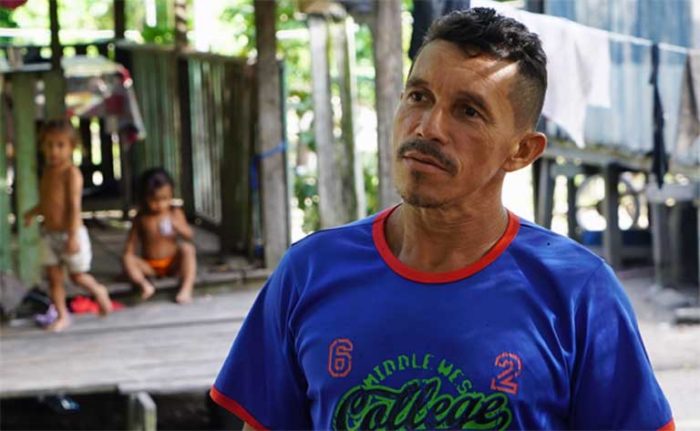
But that program isn’t popular: “It’s dangerous, as you have to collect seeds from the ground, [and] you don’t have safety equipment, and you run the risk of being bitten by poisonous animals,” in the forest, explained da Luz. This happened to Ilson dos Santos just before the Mongabay team arrived in Saracá. Ilson was bent over collecting seeds when he felt a sharp pain in his back — a venomous caterpillar. The poison it released gave him a painful bruise and fever.
He commented ruefully: “All this to earn just over 300 reais (US$60) a month!”
“If they gave us the true value of the plantation they destroyed, that would be compensation. But to get us to gather seeds and sell them to the company? That isn’t compensation,” José Domingos Rabelo complained. But he isn’t giving up. Rabelo referred to his indigenous and quilombola Afro-Brazilian heritage as a source for his dogged resistance, declaring, “I have the blood of fighters in my veins!”
Raimundo Daca employs his musical talent to tell outsiders why the people are fighting what they see as exploitation. In one song, he mourns what riverine people have lost:
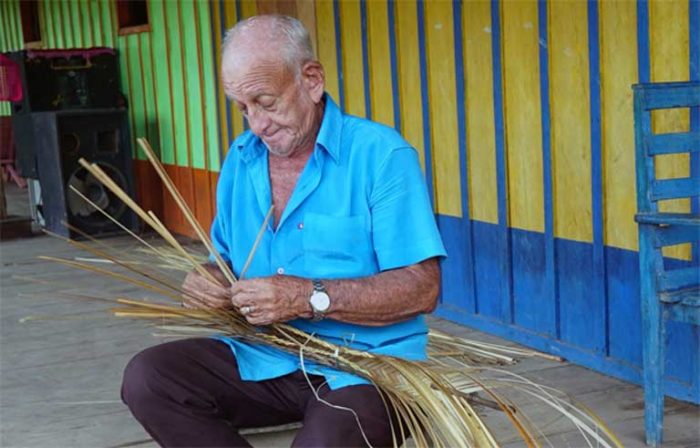
The sky is pretty, the sea prettier still
But our water today makes us really ill.
It’s there for all to see, the horrible sight
Of all that comes from the dirty bauxite.
No more fish, nor sardines, nor pacu,
Much less manatee or piracuru.
If we go to the forest, to the woods of Araticum
No Brazil trees, the tractor brought their doom.
Banner image: One of the MRN tailings system lagoons where bauxite mining waste is stored. Image by Thaís Borges.

